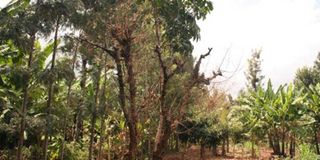Rare migration of butterflies from Meru to Embu baffles scientists, residents

Trees showing defoliation after caterpillar invasion in Chuka. Scientists have raised the alarm over the migration of butterflies from Meru to Embu, a phenomenon that has baffled residents. PHOTO | COURTESY | NATIONAL MUSEUMS OF KENYA
What you need to know:
- The insects belong to a species called Sallya boisduvali in the family Nymphalidae.
- Unlike most other migrations, this species was reported to breed along its path, helping to keep the numbers high.
- Staff from the invertebrate zoology section of NMK visited Chuka on April 2, 2016 to collect specimen.
- Motorists have claimed that the migrating butterflies have made visibility low.
Scientists have raised the alarm over the migration of butterflies from Meru to Embu, a phenomenon that has baffled residents.
The insects belong to a species called Sallya boisduvali in the family Nymphalidae, the National Museums of Kenya (NMK) announced Wednesday.
A statement from NMK public relations officer Juliana Ruto said the migration of "members of this family is not as common as those of another family called Pieridae."
"These are normally the whitish/yellowish species pretty well known by Kenyans.
“Sallya boisduvali may have migrated before but there exists no record of this happening in Kenya," she said, quoting NMK research scientists.
She added: "This may therefore be the very first record of it in Kenya."
She said butterfly experts have, however, seen the species migrate in Ethiopia "many" years ago.
She said the migration has been happening between Meru and Runyenjes in numbers that have baffled residents.
MOVE EAST TO WEST
"The general direction of migration was from West to East and normally in the hottest time of the day.
“Motorists have claimed that the migrating butterflies have made visibility low," Ms Ruto said.
Unlike most other migrations, this species was reported to breed along its path, helping to keep the numbers high.
"Thousands of larvae and pupae were observed on a particular species of tree.
“It has since been identified in the herbarium department of the museum as Sapium sp. in the family Euphorbiaceae.
“The affected trees appear dry, something that has annoyed many farmers," she said.
She said staff from the invertebrate zoology section of NMK visited Chuka on April 2, 2016 to collect specimen as well as report on the migration.
Collections were done in Giampampo in Chuka, Ms Ruto said.





